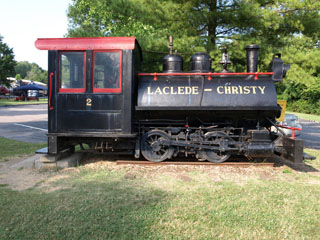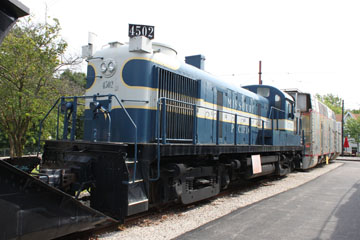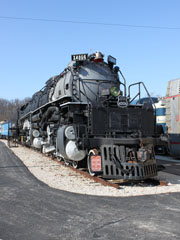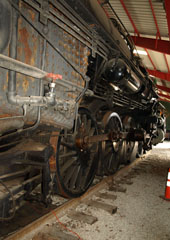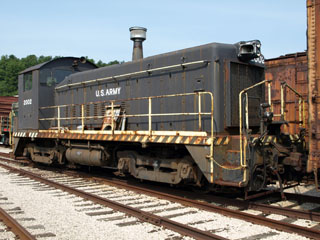

The National Museum of Transportation, St. Louis is located at 2933 Barratt Station Rd in Kirkwood, MO.
The museum was founded in 1944 by a group wanting to preserve historic transportation artefacts. After acquiring an 1870s mule-drawn street car, they formed the St Louis Railway Historical Society. The present site was identified for the museum, more streetcars were added, as well as a number of steam locomotives, and the collection continued to grow to include antique cars, boats and planes. It was taken over by the St. Louis County Parks Department in 1979, and remains a great collection, with some unusual pieces.
I have visited several times since 2008, and the photos on this page are from various different visits.
Because of the size of the museum's collection, I have broken my photo collection into two pages. This page shows locomotives displayed in the museum's yard. The National Museum of Transportation, St. Louis Train Sheds page shows locomotives stored in the museum's two train sheds.


#3 is one of two demonstrator engines built by General Motors in 1955 driven by an Oldsmobile "Rocket" V8 gasoline engine. You can see the other on the National Railroad Museum page of this website.
Following WWII, with greater car ownership, growth of the nation's interstate highway system and air services, railway passenger numbers began to decline. In response, railroads sought ways to attract passengers back, including introducing stylish trains that combined speed and added luxury. One such effort was General Motors' "Aerotrain".


The first railroad to test one of the new trains in February 1956 was the Pensylvania, but the lightweight coaches, single-axle trucks and a suspension system designed for buses, made for a very uncomfortable ride at high speed. The Pennsy was not convinced and returned the train to GM after a year of use.
GM took the trains on a tour of the country in an effort to drum up interest, but the same problems arose and no-one was willing to buy. Finally, in 1957, they were sold to the Rock Island for commuter services in Chicago, IL.

Laclede-Christy Clay Products Co., #2 stands at the entrance to the museum.
This narrow gauge (30") 0-4-0T (Tank) locomotive was built for the Purington Paving Brick Co., in Galesburg, IL, in 1907 by the Davenport Locomotive Works of Davenport, IA.
At some time, the locomotive was sold to the brick making company Laclede-Christy, and worked at the company's St. Louis, MO, plant moving car loads of clay to the brick factory.
#2 was retired in 1952 and donated to the museum.
The Davenport Locomotive Works was established in 1902 and built small steam locomotives, mainly for industrial use, but also diesel and diesel-
electrics from the 1920s. It actually produced the first diesel powered locomotive in 1927, a
30-ton diesel-electric unit for the Northern Illinois Coal Company of Boonville, IN.
Davenport bought the
H. K. Porter locomotive builders in 1950 and produced Porter designs as well as its own until closing in 1956.
You can also see a Davenport experimental gas-turbine, USA #1149, later on this page.

At first, four mules were used per ship, one each side at each end. But, as ships grew larger, up to ten were required.
Mules were actually used for side-to-side and braking control in the narrow space, with forward motion through the locks provided by the ships' engines.
#662 is one of forty "mules" built by GE in 1914 to operate on the Panama Canal. It cost $13,092 and was used on the Pacific side of the canal at the Pedro Miguel locks.
#622 is 86,300 lbs in weight and 32' 2¼" in length. Power came from 220 volt AC underground contact rails, which powered two 75 hp traction motors. Drive and braking was delivered through a toothed cog wheel on a rack rail under the locomotive, which also allowed it to climb the 44° inclines between lock chambers. It ran on 5' gauge rails.
Each mule had a winch, operated by the driver, which was played in or out to keep the ship centred in the lock while moving from chamber to chamber.
#662 was retired in 1964 when it was replaced by a newer model. It was donated to the museum that same year.


This 0-6-0 switcher was built as #49 for the Georgia Railroad by Baldwin in 1896. During its service on the GA it was renumbered #722 and then #724. In 1941, it was sold to East St. Louis Junction Railroad in National City, IL, and renumbered #17. In 1951, it was sold to St. Louis Material & Supply in Pacific, MO, and then to Basic Materials who donated it to the museum in 1964.
#724 weighs 112,900 lbs, has 49" drivers and
19" x 24" cylinders. At a boiler pressure of 180 psi, it delivered 26,510 lbs tractive effort. Its various parts have been colour coded for information purposes.

Built by the Whitcomb Locomotive Works, Rochelle, IL, in 1924, this 15 ton switcher was originally powered by a gasoline engine. However, it was later changed to a 3 cylinder 87 hp General Motors diesel engine.
With a clutch and four speed manual transmission, the engine engages the rear axle via a chain drive. The front drivers are powered by side rods. It has 30" drivers and is 19' long. The dome on the engine hood is a sand dome.
#1 worked at St. Louis City's Howard Bend Water Plant. It was bought by the museum in 1973.
Whitcomb Locomotive Works built its first small gasoline powered locomotive for an Illinois coal mine in 1906.
Baldwin bought the company in 1929 and it continued to construct small locomotives under the Whitcomb brand as a Baldwin subsidiary until 1952.


One of five electric locomotives ordered from General Electric by the Milwaukee Road in 1919 for passenger services on the newly electrified Coast Division costing $200,000 each, these were very different from the earlier EP-1 units GE had built for service on MILW's Mountain Division in 1915 (you can see EP-1 #10200 on the Lake Superior Railroad Museum page of this website).
The five units (#10250-#10254) realised immediate savings over steam locomotives, however, as they ran long distances without requiring servicing and hauled trains up grades that had required double-headed steam engines. Their distinctively modern design also made them the most famous of MILW's electric locomotives.
An interesting feature of the EP-1 was the use of motors that eliminated gearing. Armatures on each of its twelve drive axles and field poles mounted directly to the frame beside each axle made the engine almost entirely noiseless as it eliminated not only gear tooth growl but the whine of high RPM electric motors. They were not the first electric locomotives to use these so called bipolar motors but, at the time, they were by far the largest.
As well as sporting radically different exteriors, the new the locomotives were also structurally unusual. Each carbody had three sections. The end sections contained the electrical equipment and cabs within distinctive flat fronted round-top hoods. A small centre section contained a boiler for heating passenger cars. The frame was in four sections hinged at the joints, which allowed them to more easily negotiate sharp curves. Weighing 521,000 lbs and 76' long, they ran on 30,000 volts DC producing 3,517 hp on a continuous basis.
The locomotives operated on MILW's Coast Division from 1919 until 1957 and came to symbolise The Olympian, the railroad's premier passenger service between Chicago, IL, and Seattle, WA.
In 1939, the units were renumbered #E-1 - #E-5 and, in 1953, were heavily rebuilt, including adding the rounded front ends (until then, these were flat). From 1953, the EP-2s saw less and less use. In 1957, they transferred to the Mountain Division but mounting operational problems led to their retirement in 1960. All but #E-2 were scrapped. The following year, that unit was donated to the museum.



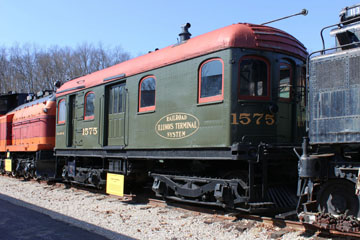
Built at the Illinois Traction System's Decatur, IL, workshops in 1918, this electric freight
locomotive was powered by four GE 69-C motors. It weighs 120,000 lbs and delivered 30,000 lbs tractive effort.
In 1937, Illinois Traction was renamed the Illinois Terminal Railroad, which it is commonly known as today. It operated 550 miles of track serving passenger and freight business in central and southern Illinois. #1575 was sold to the St. Louis Car Company Division of General Steel Industries in 1953, who donated it to the museum in 1963.

#113 was built by Alco-General Electric in 1906 as New York Central & Hudson River Class T-2 #3413. It was renumbered #3213 in 1908 and then, in 1909, was rebuilt with 4 wheel leading trucks as a Class S-2. It was renumbered #1113 in 1917 and then as #113 in 1936.
Designed to operate on the New York Central's electrified track out of Grand Central Station in New York City, thirty-two S-2s were rostered by the railroad and the last one was only retired in 1981.The NYC donated #113 to the museum in 1963.





Fate-Root-Heath in Plymouth, OH, built this propane-electric switcher in 1936 for the Joplin-Pittsburgh shortline. The company specialised in building small industrial engines and later changed its name to the Plymouth Locomotive Works. From 1910 to the late 1970s, it produced seven thousand, five hundred locomotives.
#2003 weighs 140,000 lb, has four 110 hp Westinghouse motors and a top speed of 35 mph. It moved to the Kansas City Public Service Freight Operation as #1 at some time, who donated it to the museum in 1964.

#50 is one of five experimental 1,800 hp passenger diesel locomotives built by EMC in 1935. They were the first non-articulated diesels to work on US main line railroads.
#50 hauled B&O's first diesel-powered Royal Blue service until the EA/EB units were introduced in 1937 (you can see BO EA/EB #51 on the B&O Museum Yard and Car Shop page of this website). In 1938, #50 was transferred to the Chicago & Alton and then became #1200 under the Gulf, Mobile & Ohio Railroad. It was retired in 1958 and donated to the museum.





This Decapod type (2-10-0) locomotive is one of about twelve hundred built for the Imperial Russian State Railway by US builders between 1917 and 1918. Because of the Russian Revolution, however, over two hundred of the engines were never delivered.
The undelivered locomotives were transferred to the recently established US Railroad Administration, and SLSF acquired #1621 from them in 1920 along with nineteen other "orphaned" Decapods. Over the years, they were fitted with stokers and a single thermic syphon.
Built for the Russian 5' gauge, they were not regauged for the US 4' 8½" gauge. The front pilot was replaced but the drivers were simply fitted with wider tyres.
Weighing 210,000 lbs, 184,500 lbs on its 52" drivers with a driver wheelbase of 18' 8" and engine wheelbase of 27’ 10", #1621 has 25" x 28" cylinders. With a 65 sq ft grate, 227 sq ft firebox, total heating surface of 3,189 sq ft, including 579 sq ft superheating, it operated at a boiler pressure of 180 psi delivering 51,490 lbs tractive effort.
The decapods remained in service into the 1950s. #1621 was then one of five Frisco Decapods sold to the Eagle-Picher Corporation in 1951, serving at the company's southeastern Oklahoma zinc mines until 1957. The loccomotive was donated to the museum in 1961.
All five Eagle-Picher Decapods have survived. You can see #16125 on the Eagle-Picher #1615 page of this website, #1625 on the Museum of the American Railroad page, #1630 on the Illinois Railway Museum Yard page and #1632 on the Belton, Grandview & Kansas City Railroad page.

#9908 was built in 1939 with bodywork and passenger cars by the Budd Company and engine, transmission, power truck and other equipment by EMD.
It was the ninth and last of the CB&Q's Zephyrs, one of the largest and most famous fleets of streamliners in the US.
The General Pershing was like earlier Zephyrs in having a front engine car attached to a 40' baggage car, but it was non-articulated, with each self-contained car coupled to the next rather than having shared trucks.
The General Pershing ran on its designated route until the US entered WWII, when it began to work on other routes. Silver Charger also hauled other trains after the other cars in the trainset were withdrawn. In this form, it was the last "shovel nosed" engine in service and ran until 1966 when it was donated to the museum.
Running from Kansas City to St. Louis, MO, past WWI General John J. Pershing's birthplace, the train was named General Pershing and the power car Silver Charger, after Pershing's horse.
Passenger cars bore US Army badges of rank: Silver Leaf, Silver Eagle and Silver Star.




#551 is one of three USRA design Mikado type (2-8-2) locomotives built by Lima in 1928 for the Chicago & Illinois Midland as that railroad's F-4 class.
Lima built one more F-4 for the C&IM in 1938, and the railroad also rostered two second hand Lima Milkados.
The first 2-8-2 on the Lehigh Valley Railroad in 1883 was actually a converted 2-10-2, and the name "Mikado" derives from the first 2-8-2 locomotives built by Baldwin in 1893 for Japan Railways.
#551 weighs 305,000 lbs, 226,000 lbs on its 62" drivers. With
26" x 30" cylinders, a 66.7 sq ft grate, 338.3 sq ft firebox, total heating surface of 4,442 sq ft including 940 sq ft superheating and it operated at a boiler pressure of 200 psi delivering 53,800 lbs tractive effort.
The C&IM donated it to the museum in 1955.


Built for the Youngstown & Northern Railroad as #202 by EMC in 1937, this 250,000 lb 900 hp switcher was sold to the Elgin, Joliet & Eastern in 1946 and renumbered #408. Bought by the Marinette, Tomahawk & Western it then went to the Sabine River & Northern who donated it to the museum in 1974.
#408 is one of one hundred and seventy-
five Winton engine switchers built by EMC from 1935 to 1939. The "C" in NC indicates that it has a cast steel frame. The NW series had welded frames (you can see MSTL NW1 #D-538 on the National Railroad Museum page of this website).


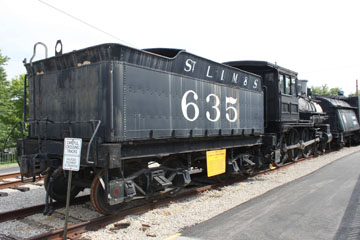
The St. Louis, Iron Mountain & Southern Railway ran from St. Louis, MO, to Texarkana, AK, as well as to southeast Missouri. It was built to haul iron ore from Iron Mountain, MO, to St. Louis. In 1883, it was acquired by Jay Gould and, in 1917, merged into the Missouri Pacific.
#635 is a Ten Wheeler (4-6-0) built by Baldwin in 1889. It weighs 147,300 lbs, has 61" drivers and
19" x 24" cylinders. With a boiler pressure of 150 psi, it delivered 18,110 lbs tractive effort. It was renumbered #2707 when it joined the MoPac, and was donated to the museum in 1947.





This St. Louis Southwestern Railway Wedge Snow Plow was made at one of the railroad's shops from a whale back tender: the fuel bunker was removed and the water tank weighted with ballast. The plow was pushed by one or two locomotives to clear snow. It was donated to the museum by Southern Pacific in 1995.
The SSW (also known as the "Cotton Belt") operated in Arkansas, Illinois, Louisiana, Missouri and Texas between 1891 and 1992. The Southern Pacific gained control in 1932, but it was not consolidated into the SP until 1992.



#4502 is one of twelve RS-3s the Missouri Pacific bought from Alco in early 1955 (#4501-#4512). Fourteen more were purchased by the railroad very soon after (#4513-#4526).
#4502 was sold in 1975 to the three mile long Bauxite and Northern Railway at Bauxite, AK. It
was then bought by Equity Grain Co-op and switched in the co-op's grain elevator yard in Houston TX. After suffering a broken crankshaft in 1992, however, it was retired. In 1995, it was purchased by a private individual who sold it to the museum.
One thousand, three hundred and seventy RS-3s were built at Alco's Schenectady, NY, works between 1950 and 1956, as well ninety-eight at its Canadian subsidiary, Montreal Locomotive Works from 1951 to 1955. It was designed to compete with similar offerings from Baldwin, EMD and Fairbanks-Morse.
#4502 weighs 229,000 lbs and is 55' 11" long. It has an Alco 244 prime mover powering a GE 581 generator to drive four GE 752 traction motors. It developed 52,500 lbs continuous tractive effort at 10 mph with a top speed of 65 mph.

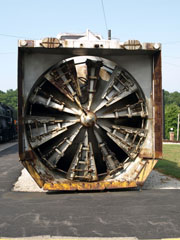


This rotary snow plow was built by the Union Pacific at its Omaha, NE, shops in 1966 using components from a variety of sources.
One of a number built at the Omaha shops from 1958 until 1971, at 367,400 lbs, however, it is the heaviest snow plow ever built.
#9000081 is 52' 2" long and 17' tall. Like most snow plows, it was not self-propelled but was pushed forward by one or two locomotives from behind at 4-6 mph. The engineer could control both the plow and pusher locomotives from the plow's cab.
The 12' rotary blades were driven by an electric generator powered by a GM/EMD 16 cylinder 3,000 hp turbo charged diesel engine. Inside, a steam generator heated the cab, prevented pipes freezing and could thaw out the rotary blades if stuck.




A total of one thousand, two hundred and sixty SD45, 6 axle diesel locomotives were built for American railroads by EMD from 1965 to 1971.
As built, they were powered by an EMD 645E3 twenty cylinder engine generating 3,600 hp. However, there were difficulties initially in setting and maintaining the firing sequence of the 20 cylinders, as well as problems making a relatively long crankshaft that would take the torque. As a result, they had a tendency to break down. EMD redesigned the shaft to reduce flexing and a number were rebuilt with 16 cylinder engines.
#3607 was bought by the Erie Lackawanna in
1967, one of thirty-five bought by the railroad from 1967 to 1968. Weighing 368,000 lbs and 65' 9½" long, it has an EMD 645E3 prime mover powering an AR10 main generator to drive six D77 traction motors. Starting tractive effort is 92,000 at 25% and continuous tractive effort is 82,100 lbs at 11 mph. Conrail acquired the locomotive in 1972 and donated it to the museum in 1986.
Many SD45s have survived. You can see the first production unit, GN #400, on the Lake Superior Railroad Museum page of this website.


Above, a panorama of Union Pacific 4-8-8-4 Big Boy #4006.
Like UP #4004 on the Cheyenne Big Boy page of this website and UP #4017 on the National
Railroad Museum page, #4006 was one of the first group of twenty of these 4-8-8-4 locomotives built by Alco in 1941 designated "Class 1" and numbered #4000-#4019. Five "Class 2" Big Boys were later built in 1944 also by Alco (#4020-#4024) and you can see photos of the only survivor from this class, UP #4023, on the Kenefick Park page of this website.
Once additional steel coal boards were fitted, however, visible in the photo on the left, they held 32 tons of coal.
Hauling heavy freight over the challenging terrain between Ogden, UT, and Green River, WY, a Big Boy could use over 13,000 gallons of water per hour.
Despite being designed for the most difficult part of the UP system, the challenge Big Boys faced is shown by the fact that they were reduced to just 3 mph on the most adverse parts, and averaged only 17 mph on the entire 24 mile Echo-Wahsatch section eastbound.
#4004 last operated in September 1957 and was donated to the museum by the Union Pacific in 1962. It has been fitted with chrome cylinder heads, which is not something I have seen on any other Big Boys, nor in any action shots of this locomotive.
Big Boys were built to a design by Union Pacific's Department of Research and Mechanical Standards to haul freight on heavy grades, particularly on the Ogden-Wahsatch district between Utah and Wyoming, but also over Sherman Hill just west of Cheyenne, WY.
Their tenders were amongst the largest ever built and were carried on a fourteen wheel (4 + 10) centipede pedestal truck initially designed for use with UP's FEF 4-8-4 locomotives. The tender weighs 342,200 lbs light and has a 56,000 lb coal and 24,000 gallon water capacity.
Above, the front end of a Big Boy is impressive, indeed.
The pilot was cast separately by General Steel Castings. An opening was left for the retractable Buckeye Steel cast coupler. In the photo above, it is in the open position with the coupler extended.

Above, a view looking along the left side of the locomotive (the
fireman's side) from the walkway leading up to the cab.

Above, a view of the controls on left side of the cab (the fireman's side).
The controls have been labelled by the museum.

Above, a view of #4006's backhead.
The Franklin butterfly fire doors were operated by a foot pedal. The 150.3 sq ft grates were designed by the Waugh Equipment Company, with manually operated grate shakers. An MB Stoker fed the 704 sq ft firebox, and the coal conveyor from the tender is fitted with sliding panels (immediately below the backhead above).
#4006 operated at a boiler pressure of 300 psi,
delivering 135,370 lbs tractive effort. The 95" inside diameter boiler is a standard straight top design but, because of the pressures exerted on it, its 1⅜" thickness was the heaviest used on a steam locomotive up until that time. It is fitted with seventy-five 22' x 2¼" and one hundred and eighty 21' x 4" tubes. With firebox, circulators and 2,466 sq ft of superheating, this gave a 5,889 sq ft total heating surface.
The boiler has five Ashcroft safety valves. All were set 2 psi apart, starting with the 300 psi operating pressure.

Above, a view looking along the right side of the locomotive (the engineer's side) from the walkway leading up to the cab.

Above, a view of the controls on the right side of the cab (the engineer's side).
The controls have been labelled by the museum.

Above, a look inside the fire box shows the circulators, grates and firing plate. The firebox is 235" x 96". To
increase the total heating surface, a very
large combustion chamber was installed immediately ahead of the firebox.
Looking in there, however, I also find it amazing what people will throw into an open fire box! Unfortunately, this view also reveals that #4006 is not in a very good condition at all: the firebox is rusted
through. In addition, two stoker valves are
missing from the backhead, as are the bell and whistle cords and the speedometer.

Left and below, Terminal Railroad Association #318 was also in the Roberts Building during my earlier visits but has subsequently been beautifully restored.
#318 was built at the Terminal Railroad's shops in Madison, IL, in 1926.


The Terminal Railroad was incorporated in 1889 to rationalise the interchange of freight and passenger trains in the St. Louis area, and was jointly owned by a number of Class I railroads, including the Missouri Pacific, the Wabash and Louisville & Nashville. It built the St. Louis Union Station in 1894, once the largest and busiest railroad station in the world, now a hotel, shopping and entertainment complex.
Today, the TRRA is owned by the Union Pacific, Burlington Northern & Santa Fe, CSX, Norfolk Southern and Canadian National.
An 0-8-0 switcher, #318 was the first engine to be built with a one piece frame and cylinder casting, one of the precursors to locomotive design that made modern steam power possible. A coal burner weighing 247,500 lbs, it has 51" drivers and 26" x 28" cylinders. It operated at a boiler pressure of 205 psi and delivered tractive effort of 60,335 lbs.
At some time #318 was sold to Commonwealth Steel/General Steel Castings, and spent most of its life switching at the company's plant in Granite City, IL.



CNW #1015 is a classic Atlantic (4-4-2)
type locomotive, one of six built in 1900 by Alco for passenger service on the Chicago & Northwestern. It is the first locomotive to have arrived at the museum in 1948, after being donated by John Russell Smith, who bought it from the C&NW in 1946.
#1015 has Stephenson valve gear, 80" drivers and 20" x 26" cylinders. Weighing 160,000 lbs, it operated at 200 psi delivering 22,100 lbs tractive effort.

The 4-8-2 Mountain type locomotive was known as a “Mohawk” by the New York Central, and #2933 is one of three hundred second generation Mohawks built between 1925 and 1930.
The NYC eventually rostered six hundred Mohawks.
One of twenty-five of the last in the series L-2a to L-2d, #2933 was outshopped by Alco in 1929 for NYC subsidiary Cleveland, Cincinnati, Chicago & St. Louis as #6233.
It was renumbered #2933 when it transferred to the NYC in 1936.
Only two Mohawks have survived (you can see the other, L-3a #3001, on the National NYC Museum page of this website). Very few NYC steam locomotives still exist because the railroad lacked interest in historic preservation. #2933 was overlooked during 1955-57 scrappings and hidden for years by employees at NYC's Selkirk Yard, NY, until donated to the museum in 1962.
#2933 was being restored the first few times I visited the museum. However, I recently received the lower photo from Al Weber of the locomotive beautifully restored by the folks at the museum.

#12 was built by Alco in 1926 for the Alton & Southern for $57,598.20. It worked in the East St. Louis, IL, terminal racking up 622,626 miles until donated to the museum in 1948. It weighs 242,000 lbs, has 53" drivers and three 22" x 28" cylinders. Operating at a 200 psi boiler pressure, it delivered 60,600 lbs tractive effort.
Right from top to bottom, the third cylinder head, the counterweights on the crankshaft looking toward the firebox, the counterweights and connecting rod looking toward the front end, and the third cylinder, guide and connecting rod.
Alton & Southern #12 is an 0-8-0 switcher and one of only four surviving US built three cylinder steam locomotives (you can see the other three on this website: UP #9000 and SP #5021 are on the Southern California RLHS page and Baldwin #60000 is on the Franklin Institute page).
Three cylinder locomotives had a brief vogue in the US in the 1920s. However, the complexity of the design made it difficult to service in the long run (although experience varied with different companies, classes and roads), and a number were later converted to two cylinder operation.




Left, during my earlier visits, SLSF Class T-54 #1522 was in the Roberts Building and looking a little worse for wear. Above and right, when I last visited, it had undergone a major cosmetic restoration.
The St. Louis, San Francisco Railway bought a total of thirty Mountain (4-8-2) type locomotives from the Baldwin Locomotive Works in Philadelphia, PA. They were designed for both freight and passenger service. Fifteen (#1500-#1514) were delivered in 1923, five (#1515-#1519) in 1925 and the last ten (#1520-#1529) in 1926.
All thirty locomotives were 88’ 6” in length from coupler to coupler, and had 69" drivers and 28" x 28" cylinders. Operating at a boiler pressure of 210 psi they delivered tractive effort of 56,800 lbs. The final ten, which included #1522, were the heaviest, weighing 360,890 lbs.
#1522 has a 40' 4" engine wheelbase and 18' driver wheelbase, and weighs 247,000 lbs on its 69" drivers. The grate is 70.3 sq ft, the firebox 405 sq ft. With a 5,620 sq ft heating surface, including 1,180 sq ft superheating, it delivered 54,085 lbs tractive effort.
#1522 was built as a coal burner, but was converted to burn oil some time in the 1930s. It was also fitted with a booster on the rear truck, which has since been removed. Retired in 1951, #1522 was donated to the museum by the SLSF in 1958.
Four other SLSF Mountains have survived: you can see #1501 on display in a park in Rolla, MO, on the SLSF #1501 page of this website, #1519 on the Railroad Museum of Northwest Oklahoma in Enid, OK, page #1526 on the Museum of the Great Plains in Lawton, OK, page, and #1527 on the SLSF #1527 page and #1529 is on the SLSF #1529 page.
From 1985 to 1988, a group of steam fans known as the St. Louis Steam Train Association restored #1522 to operating condition. It had its inaugural run to Dicatur, IL, that year and ran in many different states over the years. However, in 2002, the Association announced it could no longer afford to operate #1522 because of the high cost of insurance.
On 28th September 2002, #1522 ran a farewell excursion, billed as “The Ozark Flyer,” from the Amtrak station in St. Louis, MO, down the former Frisco mainline to Newburg, MO.



E class #502 is one of six Santa Fe type
(2-10-2) locomotives built by Baldwin in 1916 and designed for heavy freight on the Duluth, Missabe & Northern. To help it negotiate sharp curves, the centre drivers are "blind" (i.e. with no flanges). Ten more were ordered from Alco in 1919. DMIR E1 #506, one of that order is on the National Railroad Museum page of this website.
#502 weighs 346,600 lbs, has 59" drivers and 28" x 32" cylinders. At 200 psi, it delivered 71,200 lbs tractive effort.


#502 was upgraded in the late 1920s when the air tanks were relocated to the top of the boiler and a coal pusher, firebox siphons, an Elesco feedwater heater, cast iron Delta trailing truck and Franklin booster were fitted (the feedwater heater and booster were removed in the 1950s to reduce maintenance costs).
As part of the upgrade, #502 was supplied with a larger tender. Note the "dog house" for the brakeman. These were fitted on some tenders until 1937, when the law mandated a separate seat for brakemen in the locomotive cab.
As part of the upgrade, extra sand tanks were fitted on the pilot deck to improve traction on the massive ore trains hauled from the Missabe Range to Lake Superior.
#502 transferred to the Duluth, Missabe & Iron Range in 1937. It was donated to the museum by the DM&IR in 1963.



This 0-4-0F (Fireless) locomotive was de-accessioned by the museum in 2009, so is no longer in the collection.
#7 was built by the Porter Locomotive Company of Pittsburgh, PA, in 1941 for the US Navy. In 1945, it was sold to the Laclede Gas Company in St. Louis, MO. The Great Lakes Carbon Corporation then acquired it when they bought a St. Louis metallurgical coking plant from Laclede in 1950. It weighs 90,000 lbs, has 32" drivers and 22" x 18" cylinders. With a top boiler pressure of 350 psi, it developed 16,000 lbs tractive effort. You can see another Porter fireless and learn more about how they work on the B&O Railroad Museum Roundhouse page of this website.

The engine delivered 25,230 lbs tractive effort. The tender weighs 96,300 lbs with 10 tons of coal and 4,500 gallons of water.
#573 was built the same year that the Wabash Railroad came into existence as a separate entity following over fifty years of reorganisations and consolidations starting with the Northern Cross Railroad, the first railroad built in Illinois. On 8th November 1838, one of the first railroad steam locomotives to operate in Illinois ran the eight miles east from Chaplin, IL, and back to Meredosia on the Northern Cross.
The locomotive wheelbase is 22’ 4” and the driver wheelbase 14’.
#573 weighs 123,525 lbs, 1,525 lbs on its 60” drivers, with 19” x 28” cylinders. The grate is 31.97 sq ft and the firebox 153.96 sq ft. Total heating surface is 1,607 sq ft.
#573 is a Mogul (2-6-0) type locomotive one of eighteen built for the Wabash Railroad in 1899 by the Rhode Island Locomotive Works in Providence, RI, which became part of Alco in 1901.
Built to haul freight, they worked across the Wabash system.
Above, Al Wilson provided me with this photograph of the locomotive following restoration at the museum.
#573 was retained for two years after the Wabash dieselised. It was used to carry freight across a bridge over the Illinois River at Bluffs, IL, that would not support the heavier diesel locomotives. It is one of only two surviving Wabash steam locomotives. The other survivor, #543, is in the collection of the Fort Wayne Railroad Historical Society in Indiana. #573 was donated to the museum by the Wabash in 1955.


This 0-6-0 switcher was built by Baldwin in 1906 as SLSF #3695. It was sold to the Scullin Steel Co., in 1937 and renumbered #95 (the characteristic "coon skin" Frisco number plate is still evident).
#95 worked in Scullin Steel's south western St. Louis, MO, foundry and rolling mill until donated to the museum in 1956. The Scullin Steel Company ceased operations in 1981.
The engine weighs
120,30 lbs, has 49" drivers and 19" x 26" cylinders. A coal burner operating at a boiler pressure of 180 psi, it delivered 28,200 lbs tractive effort.



This 2,250 hp E8 has two Winton 567B 12 cylinder prime movers powering two GM D27 generators to drive four GM D37 traction motors. It is 70' 3" long and weighs 315,000 lbs (290,000 lbs for B units). Designed for passenger service, it has starting tractive effort of 56,500 lbs at 25%, conitinous tractive effort of 31,000 lbs at 11 mph, and a top speed of 85 mph.
Four hundred and forty-nine A units were built by EMD from 1949 to 1953, all but three for US Railroads. Forty-six B units were built from 1949 to 1954.
When Amtrak took over inter-city passenger trains in 1971, the BN retained some E units for commuter service, including #9939, which was renumbered #9902.
The unit was then transferred to the newly created Chicago Regional Transportation Authority in 1974, which became METRA in 1984. At some point, the unit was sold to Maryland Area Rail Commuter Service where it worked until 1992 as #64. It was then donated to the museum where it was restored it to its original CB&Q appearance. When I last visited, it had just been restored.
#9939A was delivered to the Chicago, Burlington & Quincy in 1950 and was one of thirty-eight eventually rostered by the CB&Q. They worked on passenger service across the system.
In 1970, the unit became Burlington Northern #9939.




You can see photos of DDA40X #6913 on the Museum of the American Railroad page of this website, #6915 on the Southern California RLHS page, #6916 on the Spencer & Hope Fox Eccles page, #6922 on the UP Challenger #3977 page and #6930 on the Illinois Railway Museum Yard page.
Built in 1971, #6944 is one of the last DDA40X diesel electrics delivered to the Union Pacific. It was donated to the museum in 1984.
Forty-seven were built between 1969 and 1971, numbered in the 6900 series to mark the centennial of driving the last spike on the transcontinental railroad at Promontory, UT, in 1869. You can see photos of the historic site at Promontory on the Golden Spike NHS page of this website. The first of the series delivered, #6900, has been preserved, and you can see photos of it on the Kennefick Park page.
This 521,980 lb, 98' 5" long, 6,600 hp unit is the most powerful single diesel electric ever built.
Two EMD 645E3A 16 cylinder prime movers powered two GM AR12 generators to drive eight GM D77 traction motors. It delivered 103,000 lbs tractive effort at 12 mph Top speed was 90 mph.

#B-2069 was donated to the museum in 1993 by the Radford Ammunition Plant in Cowan, VA.
The 240,000 lb unit is 55' 11" long, with an Alco 244D prime mover powering a GE 581 generator driving four GE 752 traction motors to deliver starting tractive effort of 90,800 lbs at 25% and 30,700 lb continuous tractive effort at 11 mph with a top speed of 70 mph. You can see other MRS-1s on the Nevada Northern Railroad Museum page of this website.
Thirteen MRS-1 units were built by both GE/Alco and EMD to the same specification for the US Army Corps in 1952. After testing, seventy more were ordered and delivered between 1953 and 1954.
The MRS-1 was designed with the prospect of another land war in Europe during the "hottest" years of the Cold War, so they were equipped with adjustable trucks to fit different railroad gauges, compact bodywork to accommodate restrictive rights of way and replaceable couplers. The land war never eventuated, however, and most went to military installations around the country.


Forty-one of these SW8 switchers were bought by the US Army in 1952. Three hundred and nine were built by EMD for US railroads from 1950 to 1954, and sixty-five for Canadian railroads by General Motors Division in Montreal.
#2002 has an EMD 8 cylinder 567B prime mover powering a GM D15C generator to drive four GM D37 traction motors. It weighs 230,000 lbs, delivers 36,000 lbs tractive effort at 11 mph and has a top speed of 65 mph.
#2002 was one of two SW8s used by US Army railway operating battalions in Korea during the Korean War.



#211 was one eight S-2 switchers bought by the Manufacturers Railway Company from Alco from 1940 to 1948.
The MRS is owned by Anheuser-Busch in St. Louis, MO. Its line connects through the Terminal Railroad Association of St. Louis to the Alton & Southern in East St. Louis, IL. It also provides maintenance services to other companies.
One thousand, four hundred and sixty-two 45' 5¾" long, 229,700 lb units were built from 1940 to 1950, and one hundred and thirty-two by the Montreal Locomotive Works from 1949 to 1961.

The S-2 was powered by Alco 539 6L turbocharged 6 cylinder diesel engines with GE GT553 generators driving four GE 731 traction motors, one on each axle. With a top speed of 60 mph, they developed 69,000 lbs tractive effort at 30% and 34,000 lbs continuous tractive effort at 8 mph.
A number of S-2s have survived. You can see NLAX #1 and what remains of RFP #C on the Gulf Coast Railroad Museum page of this website, GP #63-180 on the National Railroad Museum page and ATSF #3218 on the Pacific Southwestern Railway Museum page.

This 65 ton switcher was built by the Whitcomb Locomotive Works in 1948. It worked at the American Steel Foundries in Granite City, IL, and is typical of Whitcomb's output.
Whitcomb built gasoline and diesel electric switchers from 1907 to 1949 for industrial, mining and shortline customers.




Outshopped in 1942, this is one of the smaller industrial switchers built by GE between 1931 and 1981.
#700440 weighs 25 tons and is powered by a single Cummins 150 hp diesel engine. This was one of the most popular of the GE switchers, and five hundred and ten of this size were produced from 1941 to 1974. #700440 worked
at Curtis-Wright, McDonnell Aircraft, McDonnell Douglas and the Boeing plants in St. Louis,
MO, and is still used for switching at the museum.

Originally a 2,250 hp unit, it was upgraded to 2,400 hp by Morrison-Knudsen in 1978 with 12 cylinder EMD 567C prime movers powering two GM D27 generators to drive four GM D37 traction motors. It was then reclassified as an E9AM unit.
70' 3" long, #66 weighs 315,000 lbs. It delivered 31,000 lbs continuous tractive effort at 11 mph with a top speed of 85 mph.
This unit was delivered to the CB&Q in 1953 as E8 #9972. It was one of thirty-eight E8s rostered by that railroad and became Burlington Northern #9972 in 1970.
When the newly created Chicago Regional Transportation
Authority took over regional services from the Burlington Northern in 1974, the unit was renumbered #9906.
At some point #9906, was sold to the Maryland Area Regional Commuter (MARC) Train Service, renumbered #66 and served until retired and donated to the museum. It was subsequently sold to Ed Ellis and is now running on his Saratoga & North Creek Railway.
Another EMD E8 in the museum's collection, CBQ #9939A, is shown earlier on this page.

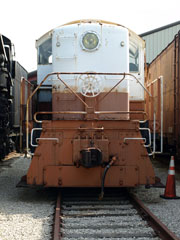

This RS-1 switcher was also de-accessioned by the museum in 2009, so may no longer be in the collection. It is 54' 11" long and weighs 240,000 lbs with an Alco 539T prime mover powering a GE GT553 generator to drive four GE 731 traction engines producing continuous tractive effort of 35,000 lbs at 8 mph and a top speed of 60 mph.
#546 was built in 1946 for the Minneapolis & St. Louis Railway. The M&STL bought thirty-five RS-1s between 1944 and 1951. #546 worked at the Burning Star #2 Mine and Kellogg Dock, IL, before being acquired by CONSOL's Truax-Traer Coal Division in the mid-1960s. It was donated to the museum in 1997.
Four hundred and sixty-nine RS-1s were built by Alco-GE between 1941 and 1953, and then by Alco from 1953 to 1960, the longest production run of any diesel locomotive for the North American market, and the carbody design pioneered the road switcher type, which has been used by most switchers built since.
The first thirteen production units were requisitioned by the US Army in 1942 and re-manufactured into six axle RSD-1s for use on the Trans-Iranian Railway. You can see the first RS-1 unit converted to an RSD-1, TXIX RSD-1 #8000, on the Museum of the American Railroad page of this website.


One one of my visits, #E550.025 was parked at the very rear of the yard. Built in 1910, this is the first electric locomotive to operate in Italy and an example of a type of motive power using the now defunct three phase electrical system (note the double sectioned pantograph: power was collected from dual overhead wires). It operated until 1962 and was donated to the US people by the Italian Government in 1968.
One hundred and eighty-six of this class were ordered and used extensively on the Giovi incline leaving Genoa. Much of the electrical system was engineered by Westinghouse-Italy.
#E550.025 was to be returned to Italy to the Museo Ferroviario Piemontese in Torino.
Related Links:
National Museum of Transportation, St. Louis Website
Georgia's Railroad History & Heritage
Milwaukee Road Historical Association
New York Central System Historical Society
Baltimore and Ohio Historical Society
Santa Fe Railway Historical & Modeling Society
Burlington Route Historical Society
Missouri Pacific Historical Society
Union Pacific Historical Society
Chicago & North Western Historical Society
Missabe Railroad Historical Society
Wabash Railroad Historical Society
Send a comment or query, or request permission to re-use an image.











